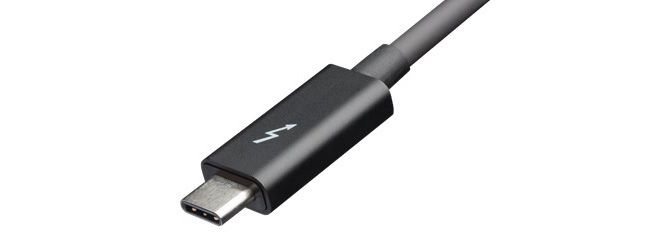Apple silicon Macs to support Thunderbolt despite shift to ARM
Apple on Wednesday clarified its stance on future integration of Intel's Thunderbolt protocol, saying Macs powered by custom-designed Apple silicon ARM chips will continue to support the connectivity technology.

The tech giant in a statement to AppleInsider said Apple silicon Macs will support Thunderbolt's latest specifications. Thunderbolt's future on Mac was in question as Apple is in the beginning stages of transitioning away from Intel's x86 architecture in favor of its own ARM designs.
"Over a decade ago, Apple partnered with Intel to design and develop Thunderbolt, and today our customers enjoy the speed and flexibility it brings to every Mac," the company said. "We remain committed to the future of Thunderbolt and will support it in Macs with Apple silicon."
Apple's promise to continue support for the specification arrives hours after Intel detailed the forthcoming Thunderbolt 4 standard in a press release. While the updated protocol retains the 40Gb/s data throughput spec from Thunderbolt 3, more stringent minimum system requirements will deliver a more robust user experience.
For example, Thunderbolt 4 offers support for two 4K displays or one 8K display, double the capability of Thunderbolt 3. PC data requirements include 32Gbps speeds for PCIe and 10Gbps for USB 3.2, USB-4 compatibility, and charging from at least one PC port. Also new is the adoption of Intel VT-d based direct memory access (DMA) protection, a feature that should improve reliability.
Apple announced the coming shift away from Intel processors at WWDC in June, noting the transition is expected to take about two years to complete. The first ARM-based Macs are rumored to arrive at the end of 2020, perhaps in the form of a small-sized portable like MacBook.

The tech giant in a statement to AppleInsider said Apple silicon Macs will support Thunderbolt's latest specifications. Thunderbolt's future on Mac was in question as Apple is in the beginning stages of transitioning away from Intel's x86 architecture in favor of its own ARM designs.
"Over a decade ago, Apple partnered with Intel to design and develop Thunderbolt, and today our customers enjoy the speed and flexibility it brings to every Mac," the company said. "We remain committed to the future of Thunderbolt and will support it in Macs with Apple silicon."
Apple's promise to continue support for the specification arrives hours after Intel detailed the forthcoming Thunderbolt 4 standard in a press release. While the updated protocol retains the 40Gb/s data throughput spec from Thunderbolt 3, more stringent minimum system requirements will deliver a more robust user experience.
For example, Thunderbolt 4 offers support for two 4K displays or one 8K display, double the capability of Thunderbolt 3. PC data requirements include 32Gbps speeds for PCIe and 10Gbps for USB 3.2, USB-4 compatibility, and charging from at least one PC port. Also new is the adoption of Intel VT-d based direct memory access (DMA) protection, a feature that should improve reliability.
Apple announced the coming shift away from Intel processors at WWDC in June, noting the transition is expected to take about two years to complete. The first ARM-based Macs are rumored to arrive at the end of 2020, perhaps in the form of a small-sized portable like MacBook.


Comments
Both Thunderbolt 3 and Thunderbolt 4 offer higher hardware requirements compared to the standard USB 3 and USB4 standards that they’re built off of, and offer a consistency that regular USB-C standards can often be sorely lacking in.
Thunderbolt 4, in particular, offers the same 40 Gbps speeds that Thunderbolt 3 had offered, but adds even stricter hardware requirements: devices will have to be able to support either two 4K displays or one 8K display, and allow for PCIe data transfer speeds of up to 32 Gbps.
This whole curfluffle, is the EXACT reason, I stopped memorizing, chips, specs, speeds, products etc, a LONG time ago...,
Just look things up when you need to!
Leave your brain free for creativity!
Thunderbolt 4 is just Intel's requirement for PC makers to force them to be competitive with Apple. Intel does this all the time with limited success.
Edit: Doh! Two 4K displays is only 1/2 of an 8K display. Sorry for the bad math. I don't know if Apple's current Thunderbolt 3 implementation supports 8K.
additionally, as far as TB 4 is concerned, VT-D is the reason I was concerned. While it’s true that TB is part of PCIE, VT-D is a technology inside Intel’s’ x86 chipsets. My concern was how Apple would implement an x86 technology. I guess we’ll find out.
info from Intel on VT-D:
https://software.intel.com/content/www/us/en/develop/articles/intel-virtualization-technology-for-directed-io-vt-d-enhancing-intel-platforms-for-efficient-virtualization-of-io-devices.html
Apple will definitely make their own Thunderbolt controller chips (just like they make their own SSD controllers and other chips for various functions) or, most likely, it will be part of their processor.
History is apparently a short coming of the average web user these days.
https://www.cultofmac.com/321363/apple-patent-explains-how-usb-c-will-make-every-other-connector-obsolete/
Jon Gruber reckoned that Apple wanted to keep its involvement low-key to further the spec’s chances of adoption.